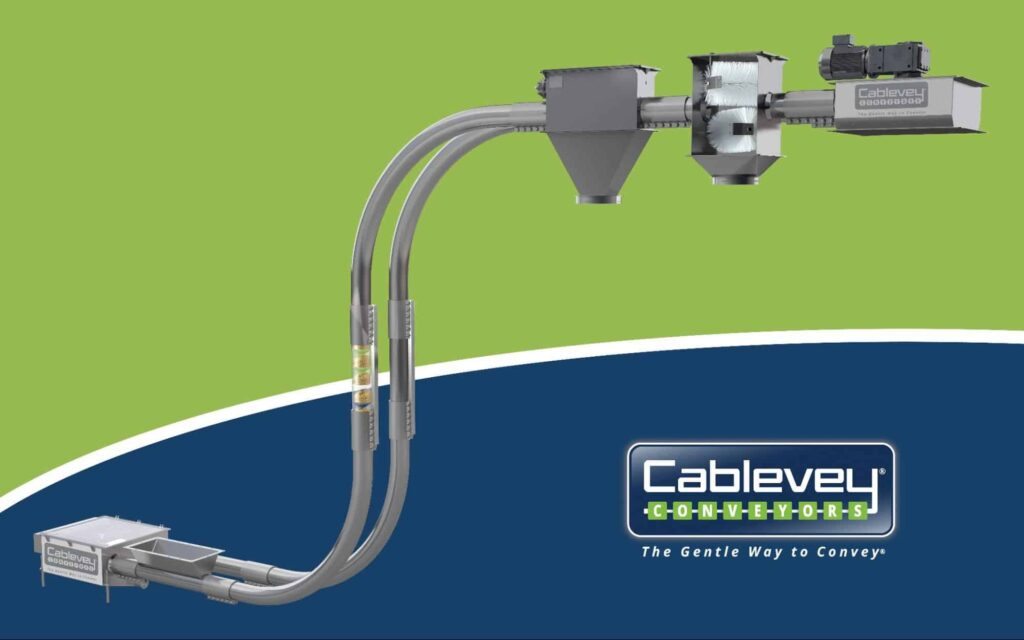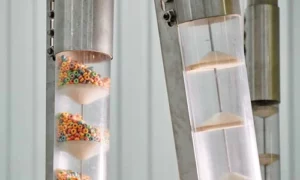In the stringent environments of industries like food and pharmaceuticals, maintaining impeccable hygiene is a must. In this guide, we’ll delve into how to keep a stainless steel conveyor clean and sanitary, unraveling the crucial steps to ensure compliance with rigorous standards. Discover the specialized measures needed to uphold the highest sanitary standards in stainless steel industrial conveyor systems.
How to Keep a Stainless Steel Conveyor Clean and Sanitary
To maintain a stainless steel conveyor in optimal condition, regular cleaning and sanitation are imperative. Start by removing loose debris, pre-rinsing the surface, applying a suitable cleaning solution, and conducting a thorough inspection. Sanitize using an appropriate solution, ensuring all areas are covered.
For enhanced efficiency, consider automated cleaning solutions like Cablevey’s clean-in-place (CIP) mechanisms. Regular maintenance, attention to design, and adherence to sanitary standards contribute to the longevity and hygiene of stainless steel conveyors.
Challenges in Achieving Sanitary Standards With Stainless Steel Conveyors
Certain industries, such as the food or pharmaceutical industry, require strict sanitary conditions. Their final products must be free of contaminants, and their manufacturing process must meet regulatory standards. One of the ways these industries achieve compliance is by using a stainless steel tubular conveyor.
Even though stainless steel is a durable material that doesn’t corrode and is easy to clean and sanitize, it is not automatically sanitary. There are special considerations that need to be taken into account to ensure that a conveying system meets the necessary sanitary standards for food production.
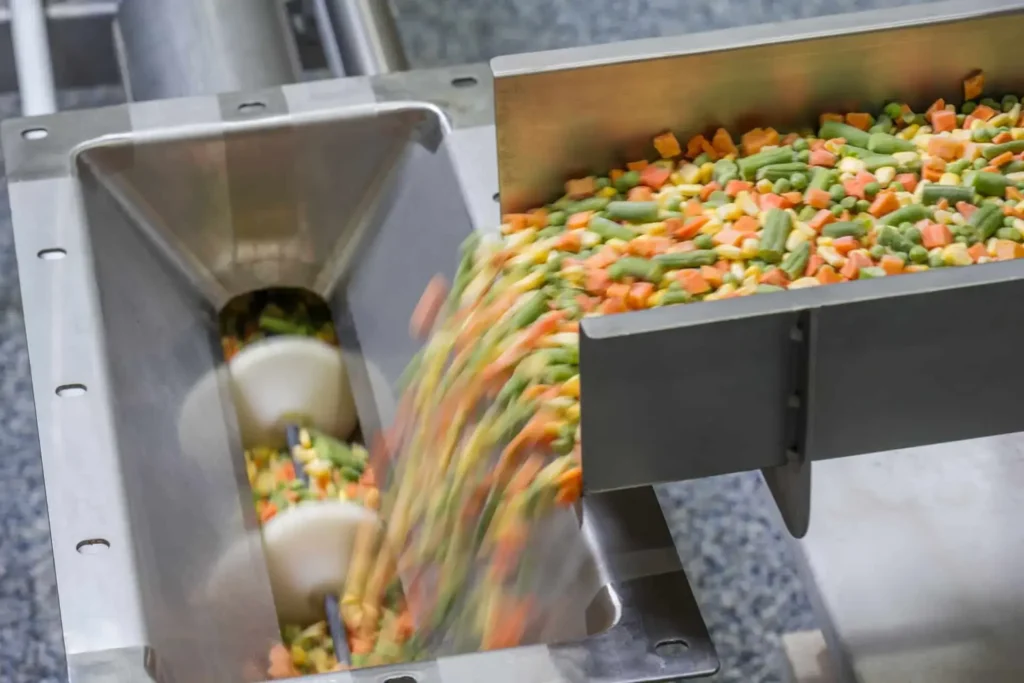
What Is the Difference Between Clean and Sanitary?
The terms “clean” and “sanitary” are often used interchangeably, but they actually have different meanings. “Clean” means free of visible dirt or other contaminants. “Sanitary,” on the other hand, means free of all contaminants, including bacteria and other microorganisms that can’t be seen with the naked eye. In other words, a clean tubular conveying system is the first step to achieving sanitary conditions. When something is clean, it isn’t necessarily sanitary. But if something is sanitary, it must also be clean.
Are Stainless Steel Manufacturing Conveyor Systems Sanitary?
The Food and Drug Administration (FDA) introduced the Food Safety Modernization Act (FSMA) in 2011 with the goal of preventing foodborne illnesses. As per data from the CDC, approximately one out of every six Americans falls ill due to foodborne diseases annually, leading to 128,000 hospitalizations and 3,000 fatalities. The FSMA put new regulations in place that food manufacturers must follow in order to reduce the risk of contamination.
Even before the FSMA was officially enacted, many food industry manufacturers hurried to upgrade their facilities and equipment to meet the new standards, including switching to stainless steel conveyors. For some reason, the widespread belief at that time was that stainless steel conveyors were automatically sanitary. However, this is not the case. Just because a conveyor system is made of stainless steel does not mean it is sanitary.
Why Use Stainless Steel Then?
If a stainless steel conveyor system isn’t sanitary by default, why would food manufacturers use them? The answer is that while stainless steel food automated conveyor systems are not sanitary on their own, they are incredibly easy to clean and sanitize. More so than any other type of material.
This is thanks to their smooth surfaces that don’t have nooks and crannies where contaminants can hide. The non-porous nature of stainless steel prevents microorganisms from seeping in. In addition, stainless steel is a very durable material. It has corrosion resistance and can withstand high temperatures, making it ideal for use in food processing facilities where deep cleaning and sanitizing are often required.
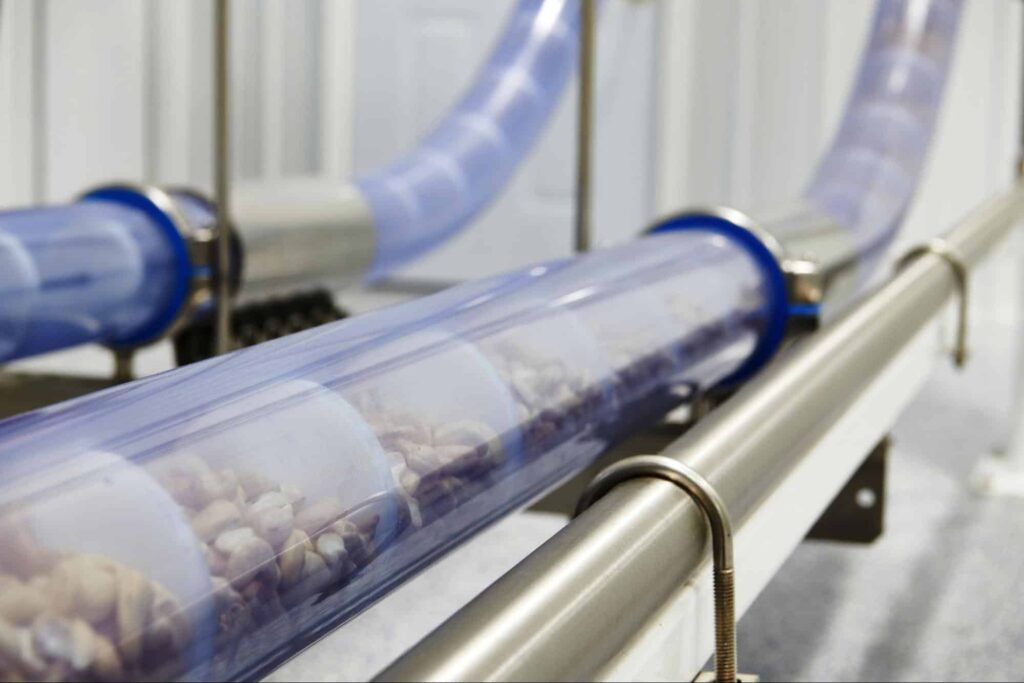
What Is a Sanitary Conveyor?
If it’s not the material, then what is it that makes a conveyor sanitary? The answer is in the way conveyors are designed. It is the way the automated conveyor system is built that determines whether it is sanitary or not. Here are some core characteristics that all sanitary conveyor designs have in common:
- Easy access to all parts of the conveyor for cleaning and inspection – If there are areas of the conveyor that are difficult to reach, it becomes much harder to clean them properly. A sanitary design will make all parts of the conveyor easily accessible.
- No traps within the design where contaminants can accumulate – This is why sanitary conveyors typically have a very simple and straightforward design. All surfaces and conveyor components should be smooth with no nooks or crannies where contaminants can hide.
- No areas where water or other cleaning solutions can pool and stagnate – Any pools that form on the conveyor are potential breeding grounds for bacteria. A sanitary design will have no areas where water can pool.
- Welds instead of fasteners – Fasteners are another potential trap for contaminants. A sanitary design will use welds instead of fasteners to join different parts of the conveyor together.
As you can see, there is more to clean conveyor solutions than just the material they are made of. The construction is also important. Keep in mind that even the best-designed conveyor manufacturing options will eventually need to be replaced if not properly maintained. Proper maintenance doesn’t only include regular cleaning but also inspecting the conveying system for signs of wear and tear. Any damaged or worn parts should be replaced immediately to prevent contaminants from accumulating.
How to Clean and Sanitize a Stainless Steel Conveyor?
Let’s say you have a stainless steel conveying system in your food processing facility. It is well-designed, and there is no damage or wear. You still need to clean and sanitize it regularly to ensure it stays sanitary. Here is a step-by-step guide on how to do that:
- Remove loose debris – By loose debris, we mean anything that is not attached to the conveyor. This includes things like food scraps, packaging material, etc. Before any actual cleaning can occur, all of this debris must be removed.
- Pre-rinse – At the very start, you will need to pre-rinse the conveyor with water. This is to remove any large particles of dirt or debris that might be clinging to the surface.
- Apply cleaning solution – Once the conveyor has been pre-rinsed, you can apply a cleaning solution. There are many different types of cleaning solutions that can be used. Just make sure you choose one that is designed for use on stainless steel.
- Inspect – Before you can move on to sanitizing, you need to inspect the conveyor to make sure it is actually clean. Look for any areas that might have been missed during cleaning. If you find any, go back and clean them again.
- Sanitize – Once the conveyor is clean, you can move on to sanitizing using a sanitizing solution. Again, there are many different types of sanitizing solutions available. Choose one that is designed for use on stainless steel.
The sanitizing solution you use may be a no-rinse, or it may require rinsing. If it requires rinsing, make sure you do so thoroughly. An important note here is that some conveyor technologies require complete disassembly for cleaning (and the mandatory unplugging of electrical components).
This is usually the case with systems that have a lot of nooks and crannies or are very complex in design. If your conveyor falls into this category, you will need to follow the manufacturer’s instructions on how to disassemble and reassemble it properly.
Can Cleaning and Sanitizing Be Automated?
Are there easier ways to clean and sanitize an automatic conveyor system than doing it manually? Can you clean a food handling conveyor without taking it apart? The answer is yes to both of those questions. Cablevey tube conveyor solutions have special clean-in-place (CIP) mechanisms that allow them to be cleaned and sanitized without disassembly.
Our CIP systems are designed to clean the main section of the conveyor – the tube – in a fast and efficient manner. Plus, they can be operated automatically, which means your workers can do other tasks while the conveyor is being cleaned.
Choosing Between Wet and Dry CIP Systems for Conveyor Sanitization
There are both wet and dry CIP options available. Wet CIP cleaning processes use water or another liquid to clean the conveyor. Dry CIP systems incorporate components such as air knives, brushes, urethane wiper discs, or specialized sponge discs in conjunction with sanitizing cleaners. Whether you opt for dry or wet CIP systems depends on factors such as the nature of the conveyed materials and their sensitivity to water.
Conveyor installation supervision is key in ensuring the proper integration of these systems, contributing to the overall efficiency and longevity of the conveying system. For tailored solutions, it’s advisable to consult reputable conveyor systems manufacturers who can provide guidance based on your specific needs and preferences.
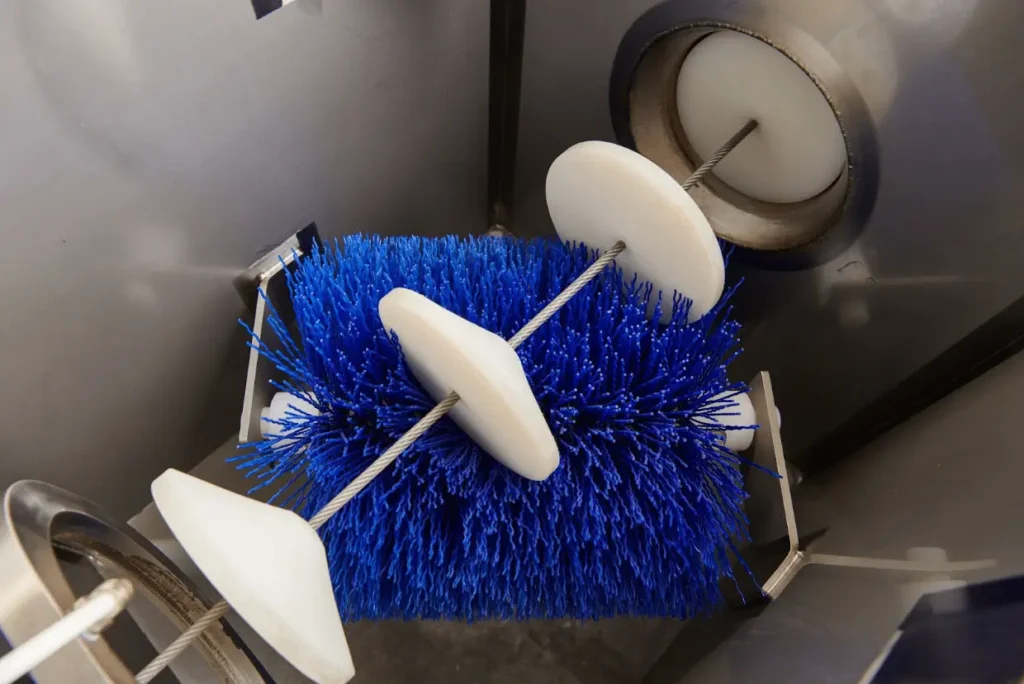
Keep Your Sanitary Standards Elevated With Cablevey Conveyors
No product handling system is sanitary by default, including stainless steel conveyors. To keep a system sanitary, it needs to be cleaned and sanitized on a regular basis. There are many different ways food processors can do this, but the most important thing is to choose a method that is effective and works for your specific needs.However, stainless steel has an advantage over other types of conveyor materials in that it is easier to clean and sanitize. This is because it is non-porous and resistant to bacteria. If you’d like to know more about our sanitary stainless steel conveyors and CIP systems, don’t hesitate to contact us. The team at Cablevey Conveyors would be happy to answer any of your questions.

